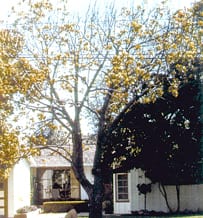Verticillium albo-atrum, V. dahliae (fungus)
Host trees include acacia, ash, aspen, beech, boxelder, black locust, camphor tree, carob, catalpa, dogwood, elm, golden-rain, hickory, horse chestnut, Indian hawthorn, linden, maple, oak, osage orange, olive, persimmon, pistachio, redbud, Russian olive, sassafras, smoke tree, tulip tree, and walnut.
this disease is known to be worldwide.
Heat, dry soil, previously infested soil are all causes.
Some trees (e.g. maple) may wilt suddenly in mid-summer, often with a large branch or one side of tree wilting and drying while the other side remains fresh. Other trees (e.g. camphor tree) wilt at tips of uppermost crowns and slowly die back. Symptoms in elm crowns resemble those of Dutch elm disease, requiring laboratory confirmation. Discoloration of sapwood varies from yellow to green to purplish brown. Slime flux sometimes develops in the bark. The disease can be chronic, with a slow dieback from season to season, the twig tips incurving to produce a “shepherd’s crook,” or it may be acute with severe wilt and death within a single season. Pistachio wilt is characterized by affected leaves hanging from dead branches over-winter, like Fire blight. Progress is slowed by adequate moisture or by high nitrogen fertilizers, such as ammonium sulfate.
This fungus is active at all times, but it is most active in warm, dry soils. It overwinters in soil by sclerotia which germinate with spring moisture to invade fine rootlets. Once inside roots, it moves through the vascular system to the tip of the plant crown, destroying vascular elements as it progresses. It may be transmitted through the soil, by infected pruning tools, or by nematodes. Vehicular tires may spread pathogen from infested soil to non-infested soil.


